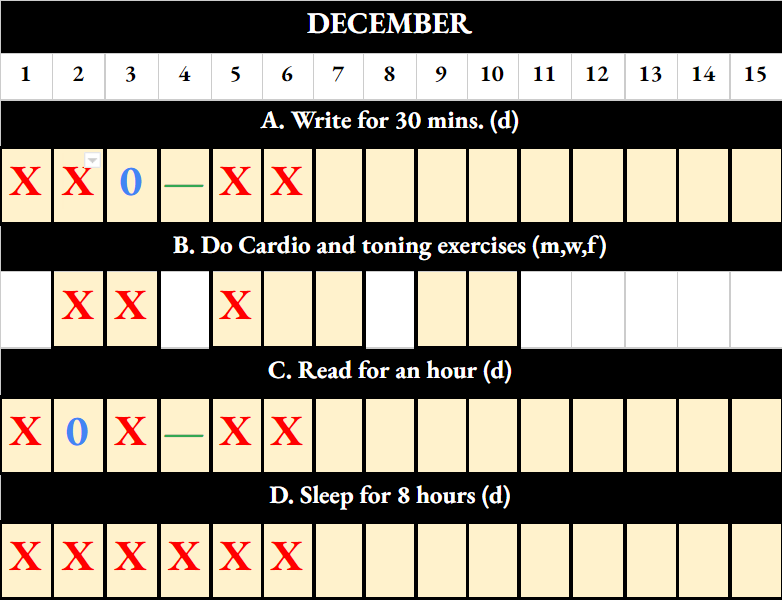A Simple Way to Track your Habits: The Martin System
What we do daily determines our whole life. According to science, half of what we do every day is repetitive, and so much of what we achieve (or do not achieve) in life depends on our habits.
Taking this into consideration, it is safe to say that if you have an end goal in mind, it’s wise to anchor it on small, sustainable habits. Here’s why:
- Habits give immediate results while goals can seem distant and intimidating
- Habits are intentional and feel more fulfilling
- Habits are easier to accomplish once established
Whatever it is that you want to do or become, it’s important to keep working towards it on a regular basis. This means developing habits that allow you to progress and see incremental results along the way.
Sure, establishing a habit does not happen overnight. But there are ways to help you stay on track and make sure your habits stick.
A simple paper-based way of tracking habits, known as the Martin System was developed in 2018 by productivity coach and podcast host Thomas Frank, named after his friend Martin Boehme who developed the system himself. The Martin System is designed to be flexible to accommodate the many unpredictable aspects of life.
Related: Try This 100-Year-Old Strategy For Reaching Peak productivity
How the Martin System Works
The Martin System can be done using a good old-fashioned pen and paper, Google Sheets, or Microsoft Excel.
It uses a two-week cycle to track habits. This means that after two weeks, you restart with a clean slate using whatever you learned from the previous cycle.
There is a dedicated section for Failure Notes to input your reasons for days when you are unable to complete the task.
And lastly, there is a Review section to take note of the things that you’ve learned during the cycle and if there are things you want to change.
To use the Martin system, follow the steps below.
Step 1: Write the list of the days across the top of the page.
Step 2: List down the habits underneath, leaving a space between each one.
Step 3: Note the days that you want to practice each habit. It can be daily, every other day, three times a week, etc. It’s all up to you.
Step 4: Draw corresponding boxes for each day that you want to build the habit.
Step 5: On the next page, create the sections for Failure Notes and Cycle Review.
Step 6: And now, you can start tracking. On successful days, put a plus (+) sign in the designated boxes, a minus (—) sign whenever you miss the habit due to laziness, and a 0 to note the days where you failed to execute the habit because of reasons that are beyond your control.

If you’re using Google Sheets or MS Excel, you can replace (+) with an X.
Step 7: For boxes that have either a minus (—) sign or a 0, you need to have a corresponding entry on the Failure section briefly explaining why the habit was not accomplished.
Step 8: At the end of each cycle, write down points you have learned during this cycle and things that you may want to tweak for the next one.
Why the Martin System Works
One of the reasons people stop tracking their habits is the frustration and feeling of failure once they break the chain. Imagine doing the habit for two months straight and then failing to do it one day because you had to do something else.
Most people will not only take it as a massive blow to their confidence, but they will also think they have wasted all that time doing something they thought was beneficial. And the longer the streak, the harder the pressure is on them to keep doing it. In that case, the task would feel more like a chore than something positive and valuable.
The Martin System offers the kind of flexibility that allows life to happen. You cannot control everything that happens to you on a given day and so you should not be taking the punishment for things that are beyond you. And because the system works in a short two-week cycle, there’s no pressure to keep doing something that might not be serving you anymore.
This system makes it easy for you to tweak your habits to accommodate any shifts in priorities or changes in the amount of available time you can dedicate towards one task.
So do you think this system will work for you?
Give it a try and let us know how it changed the way you get your goals done.
Download TaskSpur on Android | Download TaskSpur on your iPhone
Sign up or Login on your browser
Related: Try This 100-Year-Old Strategy For Reaching Peak productivity
References:
- A Better Way to Track Your Habits [VIDEO]
- (The Inforium Podcast) https://podcasts.apple.com/ph/podcast/the-inforium/id598525381